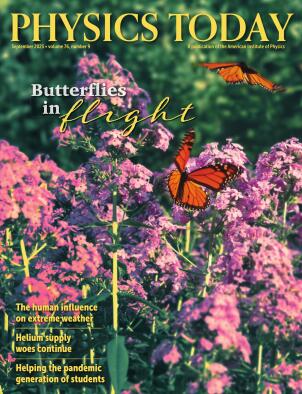John Edward Harries
DOI: 10.1063/PT.3.5314
Determining how water interacts with the long-wave radiation emitted from Earth’s atmosphere was John Harries’s research mission. He set out to explore that question through observations. His instruments flew on all the platforms available to an atmospheric physicist: aircraft, balloons, and, ultimately, satellites. His many outstanding contributions included the first detection of the greenhouse effect from the additional anthropogenic carbon dioxide. The spectroscopy of Earth’s radiation budget was his great passion, and he developed the first airborne spectrometer to measure the far-IR. He was healthily critical of models and rightly emphasized the need for measurements to test them.

John Edward Harries
HARRIES FAMILY COLLECTION

I first came across John’s work in 1987, when I started my PhD. My supervisor put in front of me a 1982 paper by John showing how the approach pursued by many researchers was unlikely to be a real test of ozone chemistry. The paper was insightful and technical, and it challenged the atmospheric-sciences community. Little did I know John would have a hugely positive influence on my research path and career.
John was born in Sedgefield, UK, on 26 March 1946. His parents were from south Wales, and he was proud of his Welsh roots. Talking rugby was a sure way to get his attention. He studied physics at the University of Birmingham. After graduating in 1967, he joined the National Physical Laboratory. He was awarded his doctorate in physics from King’s College London in 1971.
At the National Physical Laboratory, John worked on a lab spectrometer to measure the far-IR properties of greenhouse gases. He then further developed the instrument for balloon flight and for trips on the Concorde when concern grew about high-altitude planes’ impact on stratospheric ozone.
In 1980 John moved to the Rutherford Appleton Laboratory as an associate director. John’s team and colleagues from NASA made important contributions to understanding the Antarctic ozone hole. Their satellite data improved the understanding of stratospheric water vapor and circulations involving the ozone hole and enabling the transport of trace gases throughout the stratosphere.
Imperial College London appointed John to a chair in Earth observation in 1994. I joined him as a lecturer and had the immense pleasure of seeing him at work. Working with European partners, John developed the Geostationary Earth Radiation Budget instrument (GERB), whose objective was to examine the balance of the solar and outgoing long-wave radiation budget in an orbit. GERB achieved high spatial and temporal resolution of the radiation budget for the first time. John led the project, including overseeing the building of a calibration facility at Imperial. GERB was deployed on four spacecraft in the Meteosat program, run by the European Organisation for the Exploitation of Meteorological Satellites. The four launches, between 2002 and 2015, have created a unique data set to test our understanding of climate science.
Not satisfied with that alone, John also led the development of an airborne spectrometer that allowed the first far-IR measurements from an airplane. That part of the spectrum fascinated John for good reason: Much of Earth’s radiation balance is achieved by radiation emitted at those wavelengths. The European Space Agency is now pursuing a satellite version.
John was always clear about the need not just to collect data but to test theory. He was imaginative in his analysis, including a report in Nature in 2001 on the anthropogenic greenhouse effect of CO2 in which he and his colleagues combined the first satellite observations of Earth’s radiation with more recent observations. He wasn’t satisfied to rely on what the models were saying should have happened.
Between 2010 and 2013, John provided counsel to the Welsh government as its first chief scientific adviser. In that role he developed a national strategy for science—the first of its kind in Wales. He also served as president of the Royal Meteorological Society from 1994 to 1996, and he was presented with its Mason Gold Medal in 2014. John served as chair of the European Space Agency’s Earth observation program board. In 2011 he received NASA’s Distinguished Public Service Medal.
John died on 21 December 2022 in Llanbadarn Fawr, Wales. He was one of the kindest colleagues. He had time for everybody, and he had such a genuine warmth toward his students and fellow researchers.
More about the Authors
Ralf Toumi. Imperial College London.
